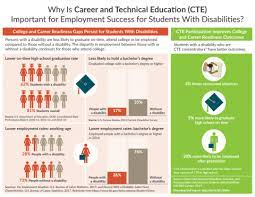Introduction:
In today’s fast-paced world, the significance of career and technical education (CTE) cannot be overstated. CTE not only equips individuals with marketable workplace-ready skills but also bridges the gap between classroom learning and real-world experiences. This article delves into an infographic highlighting the importance of CTE and why it matters for students, employers, and the global economy.
Body:
1. Employment Opportunities
CTE programs provide learners with in-demand skills that are needed in various industries. These programs lead to promising job prospects, as 80% of high-paying jobs require expertise acquired through CTE pathways. Moreover, CTE-trained professionals have higher chances of securing stable employment compared to their non-CTE counterparts.
2. Meeting Industry Demands
The growing skills gap has become a pressing concern for numerous industries. By 2030, there will be an estimated shortage of over 85 million skilled workers globally. CTE addresses this challenge by training workers in high-growth sectors like health care, information technology, and advanced manufacturing.
3. Increased Completion Rates
Students enrolled in CTE programs tend to stay in school due to the relevance of their coursework and hands-on learning experiences. As a result, high schools with CTE programs reportedly have higher graduation rates (93%) compared to the overall national average (87%).
4. Lifelong Learning Opportunities
CTE fosters continuous growth and adaptability among individuals by enabling them to acquire diverse skill sets throughout their careers. As technological advancements reshape the current job market, CTE prepares workers for continuous professional development, helping them remain competitive in today’s dynamic workforce.
5. Economic Value
Investing in CTE translates into significant benefits at both individual and societal levels. On average, graduates from a career and technical education program earn an additional $4,000 annually compared to high school graduates without CTE training. Employers also benefit, as CTE-trained workers comprise a productive, qualified, and adaptable workforce.
Conclusion:
Career and technical education is undeniably crucial in the contemporary landscape, paving the way for fulfilling employment and growth opportunities. As the infographic demonstrates, CTE not only opens doors for students to thrive in their chosen professions but also plays an integral role in alleviating skill gaps and bolstering the global economy. By embracing and investing in CTE programs, society paves a path toward an innovative, skilled, and prosperous future.




